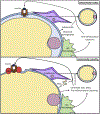Sphingolipids in adipose tissue: What's tipping the scale?
- PMID: 30473005
- PMCID: PMC11129658
- DOI: 10.1016/j.jbior.2018.10.002
Sphingolipids in adipose tissue: What's tipping the scale?
Abstract
Adipose tissue lies at the heart of obesity, mediating its many effects upon the rest of the body, with its unique capacity to expand and regenerate, throughout the lifespan of the organism. Adipose is appreciated as an endocrine organ, with its myriad adipokines that elicit both physiological and pathological outcomes. Sphingolipids, bioactive signaling molecules, affect many aspects of obesity and the metabolic syndrome. While sphingolipids are appreciated in the context of these diseases in other tissues, there are many discoveries yet to be uncovered in the adipose tissue. This review focuses on the effects of sphingolipids on various aspects of adipose function and dysfunction. The processes of adipogenesis, metabolism and thermogenesis, in addition to inflammation and insulin resistance are intimately linked to sphingolipids as discussed below.
Keywords: Adipogenesis; Inflammation; Insulin resistance; Obesity; Sphingolipid synthesis.
Copyright © 2018. Published by Elsevier Ltd.
Conflict of interest statement
Conflicts of interest
The authors certify that there are no conflicts of interest.
Figures


References
-
- Adams JM, Pratipanawatr T, Berria R, Wang E, DeFronzo RA, Sullards MC, Mandarino LJ, 2004. Ceramide content is increased in skeletal muscle from obese insulin-resistant humans. Diabetes 53 (1), 25–31. - PubMed
-
- Barbarroja N, Rodriguez-Cuenca S, Nygren H, Camargo A, Pirraco A, Relat J, Cuadrado I, Pellegrinelli V, Medina-Gomez G, Lopez-Pedrera C, 2014. Increased dihydroceramide/ceramide ratio mediated by defective expression of degs1 impairs adipocyte differentiation and function. Diabetes 64 (4), 1180–1192. - PMC - PubMed
Publication types
MeSH terms
Substances
Grants and funding
LinkOut - more resources
Full Text Sources
Medical

